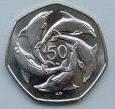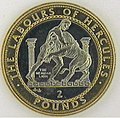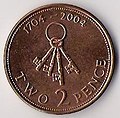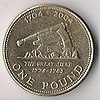Gibraltar pound
| File:Gibraltar5pounds.jpg Gibraltar £5 banknote (older note shown) | |
| ISO 4217 | |
|---|---|
| Code | GIP (numeric: 292) |
| Subunit | 0.01 |
| Unit | |
| Plural | Pounds |
| Symbol | £ |
| Denominations | |
| Subunit | |
| 1/100 | Penny |
| Plural | |
| Penny | Pence |
| Symbol | |
| Penny | p |
| Banknotes | £5, £10, £20, £50, £100 |
| Coins | 1p, 2p, 5p, 10p, 20p, 50p, £1, £2, £5 |
| Demographics | |
| User(s) | |
| Issuance | |
| Government | Government of Gibraltar |
| Website | www.gibraltar.gov.gi |
| Valuation | |
| Inflation | 2.9% |
| Source | The World Factbook, 2005 |
| Pegged with | pound sterling at par |
The Gibraltar pound (currency sign: £; banking code: GIP) is the currency of Gibraltar. It is exchangeable with the British pound sterling at par value.
History
Until 1872, the currency situation in Gibraltar was complicated, with a system based on the real being employed which encompassed British, Spanish and Gibraltarian coins. From 1825, the real (actually the Spanish real de plata) was tied to the pound at the rate of 1 Spanish dollar to 4 shillings 4 pence (equivalent to 21.67 pence today). In 1872, however, the Spanish currency became the sole legal tender in Gibraltar.[1] In 1898, the Spanish–American War made the Spanish peseta drop alarmingly and the pound was introduced as the sole currency of the colony, initially in the form of British coins and banknotes.
In 1898, the British pound was made sole legal tender, although the Spanish peseta continued in circulation until the Spanish Civil War.[1] Since 1927, Gibraltar has issued its own banknotes and, since 1988, its own coins. Gibraltar decimalised in 1971 at the same time as the UK, replacing the system of 1 pound = 20 shillings = 240 pence with one of 1 pound = 100 (new) pence.
Relationship with the British pound
The Currency Notes Act of 1934[2] confers on the Government of Gibraltar the right to print its own notes, and the obligation to back and exchange each printed note with sterling reserves at a rate of one pound to one pound sterling. Although Gibraltar notes are denominated in "pounds sterling", they are not legal tender in Britain, but they are in theory exchangeable at par for British notes at banks; in practice, at least one major British bank will not accept or exchange Sterling notes issued by the Government of Gibraltar, and others will do so at below par, as with most currency exchange. Gibraltar's coins are the same weight, size and metal as British coins, although the designs are different, and they are occasionally found in circulation in Britain.
British coins and Bank of England notes circulate in Gibraltar and are universally accepted and interchangeable with Gibraltar issues.
Tourists from Great Britain are strongly advised to change their unspent Gibraltar pounds into British currency at parity in Gibraltar before departure as those British banks which will accept them charge for exchanging the Gibraltar Pound.
Coins
| 1 pound | |
|---|---|
 
| |
| Obverse | Reverse |
In 1988, coins in denominations of 1, 2, 5, 10, 20 and 50 pence and 1 pound were introduced which bore specific designs for and the name of Gibraltar. They were the same sizes and compositions as the corresponding British coins, with 2 pound coins introduced in 1999. A new coin of 5 pounds was issued in 2010 with the inscription "Elizabeth II · Queen of Gibraltar" [3][4]
| £ 0.01 | £ 0.02 | £ 0.05 |
|---|---|---|
 |
 |
 |
Gibraltar candytuft | ||
| £ 0.10 | £ 0.20 | £ 0.50 |
 |
 |
 |
| £ 1.00 | £ 2.00 | |
 |
 |
|
The £2 coin has featured a new design every year since its introduction, as it depicts each of the 12 Labours of Hercules.
Tercentenary edition
In 2004 the Government of Gibraltar minted a new edition of its coins to commemorate the tercentenary of British Gibraltar (1704-2004).
| £ 0.01 | £ 0.02 | £ 0.05 |
|---|---|---|
 |
 |
 |
| £ 0.10 | £ 0.20 | £ 0.50 |
 |
 |
 |
skull in Gibraltar (1848) |
||
| £ 1.00 | £ 2.00 | |
 |
 |
|
(1779-1783) |
(1704) |
Banknotes
At the outbreak of World War I, Gibraltar was forced to issue banknotes to prevent paying out sterling or gold. These notes were issued under emergency wartime legislation, Ordinance 10 of 1914. At first the typeset notes were signed by hand by Treasurer Greenwood, though he later used stamps. The notes bore the embossed stamp of the Anglo-Egyptian Bank Ltd. and circulated alongside British Territory notes.[5] The 1914 notes were issued in denominations of 2 and 10 shillings, 1, 5 and 50 pounds. The 2 shilling and 50 pound notes were not continued when a new series of notes was introduced in 1927. The 10 shilling note was replaced by the 50 pence coin during the process of decimalization. In 1975, 10 and 20 pound notes were introduced, followed by 50 pounds in 1986. The 1 pound note was discontinued in 1988. In 1995, a new series of notes was introduced which, for the first time, bore the words "pounds sterling" rather than just "pounds". The government of Gibraltar introuduced a new series of banknotes beginning the 10 and 50 pound sterling notes issued on July 8, 2010. On May 11, 2011, the 5, 20 and 100 pound sterling notes were issued. [6]
| Current GIP exchange rates | |
|---|---|
| From Google Finance: | AUD CAD CHF CNY EUR GBP HKD JPY USD |
| From Yahoo! Finance: | AUD CAD CHF CNY EUR GBP HKD JPY USD |
| From XE.com: | AUD CAD CHF CNY EUR GBP HKD JPY USD |
| From OANDA: | AUD CAD CHF CNY EUR GBP HKD JPY USD |
See also
- Economy of Gibraltar
- Coins of the Gibraltar pound
- Currency board
- Highest-valued currency unit
- Christopher Ironside OBE coin designer: reverse design of the 25 New Pence coin, Barbary Ape (issued 1971).
References
- ^ a b Bond, Peter (2003). 300 Years of British Gibraltar 1704-2004. Peter-Tan Publishing Co. p. 89.
- ^ Government of Gibraltar (1934). "Currency Notes Act" (PDF). Retrieved 2007-08-05.
{{cite web}}: Unknown parameter|month=ignored (help) - ^ http://www.the-rock-of-gibraltar.com/Gibraltar-News/8931/queen-of-gibraltar-gibraltar-queen-coin-fivepoundcoin-queenofgibraltar
- ^ This issue caused controversy in Spain. The title of King of Gibraltar historically corresponds to the crown of Castile and not to England. polemica-en-ambitos-diplomaticos-por-la-asistencia-de-la-reina-dona-sofia-a-los-actos-de-homenaje-a-isabel-ii
- ^ Linzmayer, Owen (2012). "Gibraltar". The Banknote Book. San Francisco, CA: www.BanknoteNews.com.
- ^ Gibraltar new note family now complete
- Krause, Chester L.; Clifford Mishler (1991). Standard Catalog of World Coins: 1801–1991 (18th ed.). Krause Publications. ISBN 0873411501.
- Pick, Albert (1994). Standard Catalog of World Paper Money: General Issues. Colin R. Bruce II and Neil Shafer (editors) (7th ed.). Krause Publications. ISBN 0-87341-207-9.
External links

